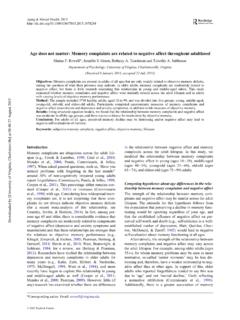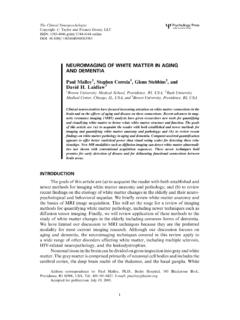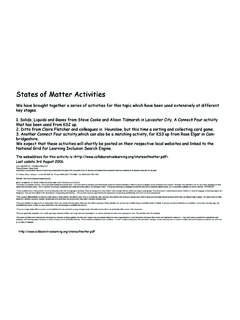Transcription of Correlations between MRI white matter lesion location and ...
1 DOI ;76;1492-1499 neurology Smith, Salat, J. Jeng, et al. executive function and episodic memoryCorrelations between MRI white matter lesion location andThis information is current as of April 25, 2011 on the World Wide Web at: The online version of this article, along with updated information and services, isEnterprises, All rights reserved. Print ISSN: 0028-3878. Online ISSN: 1951, it is now a weekly with 48 issues per year. Copyright Copyright 2011 by AAN is the official journal of the American Academy of neurology . Published continuouslyNeurology Correlations between MRI white matterlesion location and executive function andepisodic Smith, MD, Salat, PhDJ. Jeng, McCreary, PhDB. Fischl, Schmahmann, Dickerson, MDA. Viswanathan, MD, Albert, PhDD. Blacker, MD, Greenberg, MD,PhDABSTRACTO bjectives:MRI white matter hyperintensity (WMH) volume is associated with cognitive impair-ment.
2 We hypothesized that specific loci of WMH would correlate with cognition even after ac-counting for total WMH :Subjects were identified from a prospective community-based study: 40 had normalcognition, 94 had mild impairment (defined here as a Clinical Dementia Rating [CDR] score of dementia), and 11 had mild Alzheimer s dementia. Factor analysis of a 22-item neuropsy-chological battery yielded 4 factors (episodic memory , executive function, spatial skills, and gen-eralknowledge). :Higher WMH volume was independently associated with lower executive function andepisodic memory factor scores. Voxel-based general linear models showed loci where WMH wasstrongly inversely associated with specific cognitive factor scores (p ), controlling forage, education, sex,APOE genotype, and total WMH volume.
3 For episodic memory , clusters wereobserved in bilateral temporal-occipital and right parietal periventricular white matter , and theleft anterior limb of the internal capsule. For executive function, clusters were observed in bilat-eral inferior frontal white matter , bilateral temporal-occipital and right parietal periventricularwhite matter , and the anterior limb of the internal capsule :Specific WMH loci are closely associated with executive function and episodic mem-ory, independent of total WMH volume. The anatomic locations suggest that WMH may causecognitive impairment by affecting connections between cortex and subcortical structures, includ-ing the thalamus and striatum, or connections between the occipital lobe and frontal or 2011;76:1492 1499 GLOSSARYAD Alzheimer disease;CADASIL cerebral autosomal dominant arteriopathy with stroke and ischemic leukoencephalop-athy;CDR Clinical Dementia Rating;DSM-IV Diagnostic and Statistical Manual of Mental Disorders,4th edition;FA fractional anisotropy;MCI mild cognitive impairment;PDW proton density-weighted;SPGR spoiled gradient recalled;T1W T1-weighted;T2W T2-weighted;TE echo time;TR repetition time.
4 WMH white matter is growing recognition that ischemic brain lesions are a significant contributor to cogni-tive impairment and that many cases of dementia are mixed, with a cerebrovascular white matter lesions, seen on MRI as white matter hyperintensity (WMH),have previously been associated with decreased performance on neuropsychological testing,2,3and risk of mild cognitive impairment4and has been hypothesized that WMHinterfere with cognitive processing by impairing the speed or fidelity of signal transmissionthrough affected direct evidence to support this hypothesis is scant, reasoned that if WMH impair white matter function, then clinical impairments should beassociated with WMH in discrete loci involving white matter tracts connecting cortical networksserving those clinical functions.
5 For example, WMH in specific occipito-parietal periventricularFrom the Department of Clinical Neurosciences ( ), Hotchkiss Brain Institute ( , ), and Department of Radiology ( , ),University of Calgary, Canada; Martinos Biomedical Imaging Center ( , , , ), Department of neurology ( , , , ), Department of Psychiatry ( ) and Gerontology Research Unit ( ), Massachusetts General Hospital, Boston; and Department ofNeurology ( ), Johns Hopkins University, Baltimore, funding:Supported by the National Institute on Aging (P01 AG04953, R01 AG26484) and the National Institute of Neurological Disordersand Stroke (R01 NS062028).Disclosure:Author disclosures are provided at the end of the correspondence andreprint requests to Dr. Eric , Department of ClinicalNeurosciences, Foothills MedicalCentre, Room C1212, Calgary,AB, T2N 2T9, 2011 by AAN Enterprises, have previously been associated with , specific regions of ab-normal fractional anisotropy (FA) have beenidentified in the frontal white matter that areassociated with executive dysfunction in the he-reditary small vessel disease cerebral autosomaldominant arteriopathy with stroke and ischemicleukoencephalopathy (CADASIL).
6 8In order to better understand the relationshipbetween WMH location and cognitive impair-ment, we determined the correlation betweenWMH involvement in specific regions and neu-ropsychological test performance in subjectsparticipating in a prospective study of were drawn froma longitudinal prospective cohort study of predictive factors for tran-sition to dementia. The details of study subject recruitment andassessment have been previously subjects were re-cruited through community advertising seeking older individualswith and without memory impairment. To be included in thestudy, all participants had to be 65 or older and to have an infor-mant as a collateral source of information. At entry to the parentstudy, persons with dementia, major vascular risk factors (atrial fi-brillation or diabetes mellitus requiring insulin), history of stroke, orclinical diagnosis of cognitive impairment due to medical disorderssuch as hypothyroidism were semi-structured interview by an experienced clinician wasused to evaluate the subjects at study entry and at each subse-quent year, as previously described,9,10to generate a Clinical De-mentia Rating (CDR) subjects who developeddementia during the study, the underlying disorder was diag-nosed by consensus of the investigators using all available studyinformation.
7 Dementia was defined using criteria from theDSM-IV,12probable Alzheimer disease (AD) was diagnosed us-ing the National Institute of Neurological and CommunicativeDisorders and Stroke Alzheimer s Disease and Related Disor-ders Association criteria,13and vascular dementia was diagnosedaccording to the National Institute of Neurological Disordersand Stroke Association Internationale pour la Recherche enl Enseignement en Neurosciences with mildly impaired cognition at the time of MRI, de-fined as a CDR score of without dementia, are defined here asmild cognitive impairment (MCI).4,15 The distribution of CDRsum of boxes scores among the mildly impaired subjects was broad(see table 1). At the mild end of the spectrum, many subjects wouldnot meet psychometric cutoffs commonly used to select MCI sub-jects in epidemiologic studies and clinical trials,16and could be con-sidered early MCI.
8 The subjects at the more impaired end of thespectrum ( , CDR sum of boxes 2) are comparable to MCIsubjects recruited in these settings, based on likelihood of progres-sion to a diagnosis of use MCI here to refer to the entiregroup of mildly impaired 22-item neuropsycho-logical battery was administered to all study me-Table 1 Study population characteristicsaCharacteristicNormal cognition(n 40), %MCI(n 96), %Mild dementia(n 11), %pValueAge, , >1 APOE 4 >1 APOE 2 sum of boxes0 (0, 0)1 (1, 2)5 ( , 5) , % ( , ) ( , ) ( , ) >1 lacunar test factor scoreEpisodic : CDR Clinical Dementia Rating; MCI mild cognitive impairment; WMHr total white matter hyperinten-sity volume, expressed as percentage of intracranial are percentages, mean SD, or median (25th, 75th percentile).
9 PValues are by Fisher exact test, testing forsignificant differences across all 3 76 April 26, 20111493dian time between MRI and neuropsychological testing was 76days (interquartile range 19 219 days). Details of the battery,including the individual test items, have been previously de-scribed (table e-1 on theNeurology Web site at ).17,18A factor analysis of the neuropsychological measuresyielded a 4-factor representation of the overall test battery: 1)general knowledge, 2) episodic memory , 3) spatial skill, and 4)executive factor scores were standardized to havezero mean and unit variance among the cognitively normal studysubjects, adjusted for age and underwent MRI on either of scanners (Signa, General Electric Medical Systems, Mil-waukee, WI).4A sagittal localizer, coronal T1-weighted (T1W)spoiled gradient recalled (SPGR), and dual echo sequence, yield-ing proton density-weighted (PDW) and T2-weighted (T2W)images of the whole head, was performed.
10 T1W SPGR sequenceparameters were as follows: repetition time (TR) 35 msec, echotime (TE) 5 msec, flip angle 45 degrees, slice thicknesswith no interslice gap. Dual echo sequence parameters were asfollows: TR 3,000 msec, TE1 30 msec (for PDW images), TE280 msec (for T2W images), and slice thickness 3 mm inter-leaved. The matrix was 256 192, and field of view 24 cm, forall work in this study population has shown thattotal WMH volume was associated with the risk of progres-sion from normal cognition to take advantage ofadvances in computer processing, we have revised our meth-ods for WMH segmentation, using custom-designed algo-rithms implemented in the FreeSurfer image analysis suite( ). Briefly, this processingincludes motion correction, removal of nonbrain tissue using ahybrid watershed/surface deformation procedure, automatedTalairach transformation, segmentation of the subcortical whitematter and deep gray matter volumetric structures, intensity nor-malization, tessellation of the gray matter white matter bound-ary, automated topology correction, and surface deformationfollowing intensity gradients to optimally segment borders at thelocation where the greatest shift in intensity defines the transi-tion to the other tissue structural segmentationswere used to identify regions where WMH was possible whileexcluding regions where WMH does not occur (that is, corticaland subcortical gray matter structures).









